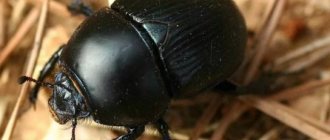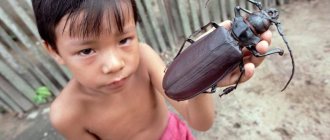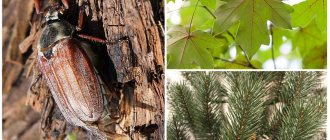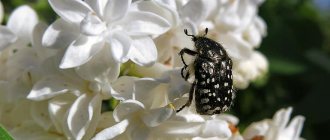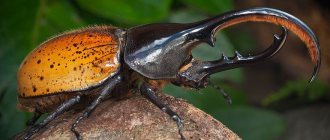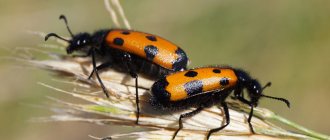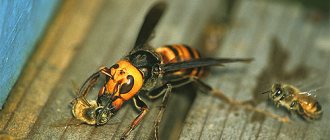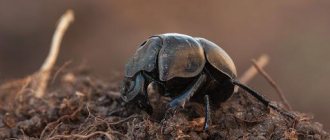There is no point in being offended by this: Mother Nature already came up with everything long ago before us. Bacteria, as it turned out, have functional wheels (people only got around to them 7 thousand years ago), ants “invented” agriculture, spotted salamanders learned to use solar panels (though only at the embryonic stage). It's even funnier that when it comes to horror and trash, nature is even more ahead of us. Lovecraft dreamed up his “indescribable beasts” by looking at a banal plate of seafood. Clive Barker wrote The Midnight Meat Train and The Skin of Fathers while thinking about the behavior of insects. Everything is clear about the creators of “Sharknado” - they didn’t bother at all.
So we can hardly come up with anything more frightening than the creatures that exist in nature. Think of the cordyceps zombie fungus, or the killer bug that vomits into the insides of its victims, eats them, and then makes camouflage out of their dead bodies.
Poisonous killer beetle
According to scientists who have studied the fossil record of insects, the wide diversity of the insect world is associated with a large number of new species constantly appearing. One of these is a species of beetle recently discovered by scientists, which is capable of killing everything around with its poison, including large animals and people.
These insects are so tiny in size that they are difficult to see with the naked eye. There are cases where victims of beetles received fatal bites in a situation in which they accidentally stepped on them with their feet or leaned on them with their palms.
The poison released by the insect instantly penetrates through the wound under the skin, provoking the rapid development of an irreversible destructive process. Scientists have not yet developed an antidote to the toxin.
The most dangerous killer beetle has been discovered in India. The nature of the origin of tiny, but incredibly dangerous creatures has not yet been clarified. According to one version, insects are the “fruits” of prohibited experiments in the creation of biological weapons or “waste material” of unsuccessful laboratory research.
At the moment, the killer beetles are localized within the South Asian country. It is difficult to determine how quickly they will spread around the world. For residents of India, the situation is aggravated by the factor of overpopulation. Moreover, the majority of people are below the poverty line. People often do not have any shoes and walk on the ground barefoot, risking “running into” a dangerous enemy.
Scientists are now faced with two tasks: to develop an antidote and to prevent the expansion of the range of deadly insects.
Spider experiment
To find out why beetles make these “gentle” touches, scientists decided to conduct an experiment. They brought to the laboratory 30 individuals of Pholcus phalangioides, which are spiders no larger than one centimeter in size. Scientists placed the tiny creatures on webs and began tapping some of their bodies with dog hair to imitate the gentle touch of killer bugs. After this, they knocked on a tuning fork installed in the corner of the web, the vibrations of which imitated the movements of the trapped victim.
Spider Pholcus phalangioides
It turned out that after tapping, the spiders responded to vibrations much more calmly. In some cases, they completely ignored the tuning fork, while other individuals ran to look at the prey. The researchers concluded that small taps seem to spiders to be touched by their relatives or potential partners, so they calm down. According to one of the authors of the scientific work, Anne Wignall, this feature prevents spiders from accidentally eating their relatives. Their worst enemies, killer beetles, actively take advantage of this.
Stenolemus assassin beetles are also not particularly large
According to zoologist Ondrej Michalek, who was not involved in the scientific work, the conclusions of his colleagues are fully justified. As an expert on invertebrate creatures, he noted that many spiders avoid cannibalism by relying on tactile signals. Over the years, enemies of spiders have been able to notice this and take advantage of it. In the future, the authors of the scientific work want to find out exactly how many taps need to be made on the spider’s body in order to calm it down. After all, if you make them too few or too many, an arthropod predator may sense something is wrong and defend itself from its rival. Scientists also want to find out what types of spiders this trick can be used against.
Kissing bugs
The so-called kissing bugs also pose a great danger. They are nocturnal. Killer beetles got their name from their predilection for stinging people on the mucous membranes of their lips and eyelids while they are asleep. Coleopteran predators are attracted by the carbon dioxide released during human respiration. Infection occurs at the moment of blood sucking and at the stage when the victim instinctively rubs the bite site, rubbing in the feces left by the parasites at the “crime scene.”
Within a couple of weeks after infection, a person’s eyelids swell, fever appears and acute heart failure develops, in most cases leading to death.
Parasitic protists live in subtropics and tropical regions.
The bite of trypanosoma cruzi causes people to develop Chagas disease, which is difficult to treat. According to medical estimates, today about 7-8 million people suffer from tropical parasitic disease. These are mainly residents of South and Central America, as well as Mexico. 12.5 thousand people die from this disease every year.
The most surprising thing is that, despite such a colossal scale, the WHO still ranks Chagas disease as one of the ten most “neglected” tropical diseases. There is still no vaccine against this common disease.
3
The secret to the flight efficiency of miniature winged beetles is a wide figure of eight and high angles of attack.
Rice.
1. Examples of ptilopterygia - feathery wings of representatives of different orders of insects:
A
-
Primorskiella anodonta
(Coleoptera),
B
-
Megaphragma mymaripenne
(Hymenoptera),
C
-
Heliothrips haemorrhoidalis
(thrips). Microphotographs from the book AA Polilov, 2016. At the Size Limit - Effects of Miniaturization in Insects and articles by AA Polilov et al., 2022. Wing morphology in featherwing beetles (Coleoptera: Ptiliidae): Features associated with miniaturization and functional scaling analysis
Miniaturization occurred independently during evolution in several groups of insects, leading to the emergence of multicellular organisms comparable in size to large unicellular ones. The smallest free-living (non-parasitic) insects belong to the periptera (family Ptiliidae within the order Coleoptera - coleoptera, also known as beetles). Most winged wings are capable of flight, and their wings, during miniaturization, began to resemble the feathers of birds. This phenomenon, characteristic of most miniature insects, is called ptilopterygia. The independent occurrence of ptilopterygia in different groups of insects is associated with the characteristics of flight under conditions when the forces of viscous friction are comparable to the forces of inertia. In general, the smaller the flying animal, the slower it flies, and it has long been a common belief that small insects are incapable of fast and agile flight. New data obtained using high-speed video filming refute this assumption. In particular, relatively large featherwings fly as well as their related beetles, three times as large .
larger sizes.
In one of the studied species of featherwings, Acrotrichis sericans,
a record relative speed of horizontal flight was noted, allowing the beetle to cover a distance in a second that is almost 1000 times the length of its body.
The specific flight mechanism developed by feather wings during miniaturization allowed them to “reach a new level”, so that now they can fly on their feathery wings no worse and in some ways even better than larger beetles on membranous (membranous, common) wings. type) wings. Now this mechanism has been described in detail for the first time using the example of another beetle from the same family - Paratuposa placentis
: the feathery wings describe a wide figure eight in the air, collapsing above and below the body, and the elytra move with considerable amplitude, playing the role of an inertial brake and compensating for the rotational vibrations that arise in flight bodies.
Among insects (class Insecta) from different orders there are very miniature ones - they are called microinsects. This loose term refers to insects whose size is less than 2 mm. During miniaturization, microinsects from different orders convergently (through independent evolution in similar directions) acquired some similar morphological characteristics under the influence of natural selection. In particular, the vast majority of microinsects have a unique wing structure: almost all the veins on the wing are reduced, the wing plate is short and very narrow, and its edges are bordered by long setae, which make up more
most of the wing area (see picture of the day Wing of the smallest beetle).
This complex of characters is called ptilopterygia
(Fig. 1).
It has long been thought that the miniature insects fly primarily or exclusively passively, moving through the air primarily by wind, much like plankton moves primarily by water currents. (These wind-borne animals are called aeroplankton.) It would be hard to imagine that tiny insects, comparable in size to single-celled protists and with intricate feathery wings, could fly quickly and maneuverably.
Rice. 2.
Beetles from the family Ptiliidae (featherwings).
A
,
B
-
Nossidium pilosellum
;
C
,
D
-
Limulodes parki
;
E
,
F
-
Scydosella musawasensis
;
G
,
H
—
Primorskiella anodonta
;
I
,
J
-
Ptenidium formicetorum
;
K
,
L
-
Acrotrichis montandoni
. Images obtained on a scanning electron microscope, from the article AA Polilov et al., 2022., The phylogeny of Ptiliidae (Coleoptera: Staphylinoidea) – the smallest beetles and their evolutionary transformations, dedicated to the phylogeny of peripterans
Many entomologists also considered the beetles (family Ptiliidae), which include the smallest free-living (non-parasitic) insects, to be poor flyers (Fig. 2). But recent research conducted by our group, based at the Department of Entomology, Faculty of Biology, Moscow State University. M.V. Lomonosov, showed that the smallest beetles are quite capable of active and maneuverable flight (D. Kolomenskiy et al., 2022. Aerodynamic performance of a bristled wing of a very small insect). Moreover, as we have recently discovered, some of the miniature insects with feathery wings fly more efficiently than similarly sized insects with conventional membranous wings (SE Farisenkov et al., 2022. Extraordinary flight performance of the smallest beetles).
We studied the flight efficiency of miniature beetles from the family Ptiliidae and compared it with the flight efficiency of larger beetles with ordinary membranous (membranous) wings - members of the related families Silphidae (carnivores) and Staphylinidae (rove beetles). All three families belong to the superfamily Staphylinoidea (Fig. 3) and diverged in the course of evolution relatively recently - certainly later than the evolutionary branch of this superfamily diverged from most other beetles.
Rice. 3.
Ptiliidae, Silphinae, and various subfamilies of rove beetles (Staphylinidae: all names ending in -inae correspond to subfamilies), as well as some other families of beetles on one of the recent versions of the phylogenetic tree of the superfamily Staphylinoidea. Based on data from D. D. McKenna et al., 2014. Phylogeny and evolution of Staphyliniformia and Scarabaeiformia: forest litter as a stepping stone for diversification of nonphytophagous beetles
The insects were placed in special flight boxes, where their flight was recorded on two synchronous high-speed cameras with high resolution. The shooting frequency ranged from 60 to 300 frames per second. In addition to regular light, the flight boxes were illuminated on three sides with powerful infrared radiation with a wavelength of 850 nm, invisible to the beetles. This made it possible to provide the exposure necessary for video recording, but without creating unnaturally bright lighting, which could affect the behavior of the experimental beetles. Based on the positions of each insect in each frame, three-dimensional trajectories of its movement were reconstructed, from which we subsequently calculated various flight characteristics.
In all three families, average and maximum flight speeds increase with body length (Fig. 4). However, the trends in the maximum and average flight speeds of winged insects are noticeably higher than the trend lines obtained for carrion beetles and rove beetles. This shows that winged wings can develop b o
higher average speeds than rove beetles of similar size.
Rice. 4.
Flight parameters and body sizes of beetles from close families: featherwings (
left
), rove beetles (
center
) and carnivores (
right
).
A
- average and maximum speed;
B
- average and maximum horizontal speed;
C
is the maximum horizontal acceleration. Graphs from the article SE Farisenkov et al., 2022. Extraordinary flight performance of the smallest beetles
The maximum horizontal acceleration that featherwings can achieve is significantly higher than that of rove beetles, and approximately twice as high as that of carnivores. If we compare relative values (measured in body lengths), then the average speed of horizontal flight of different types of winged wings ranges from 146 to 437 body lengths per second. This is also significantly greater than that of rove beetles and carrion beetles (for which this figure is 28–123 body lengths per second). That is, the flight characteristics of featherwings are comparable to the flight characteristics of rove beetles and carrion beetles of much larger size. This is despite the fact that there is a (loose) “rule”: the smaller the flying animal, the slower it flies. Moreover, the feather beetle Acrotrichis sericans
capable of developing
higher
average speed than rove beetles three times longer than it. At the same time, he covers a distance in a second that is 975 times the length of his body. This is a real record: such a high relative speed of movement in the horizontal plane has not yet been recorded in any animal.
Two factors may contribute to this unusually high flight efficiency. The first of these is the relative volume and fine structure of the muscles, since muscle power depends on them. The volumes and structure of the muscles of beetles were not studied as part of our work, but it is known that during miniaturization the relative volumes of the muscles of beetles do not increase (unlike Diptera, even the smallest representatives of which have membranous wings) (AA Polilov, 2015. Consequences of miniaturization in insect morphology). The second factor is the unusual morphology and kinematics of the wings, which are more suitable for flight at miniature sizes.
For the flight of miniature insects, friction forces are of great importance, and inertial forces recede into the background. The fact is that viscous friction forces are proportional to the surface area, and inertial forces are proportional to the mass of the body. As the size of a body decreases, the relative (compared to the mass) surface area of the body increases, because the absolute surface area is proportional to the square of the linear dimensions, and the mass, like the volume, is proportional to the cube of the linear dimensions. When the linear dimensions are reduced, for example, by a factor of 10, the surface area is reduced by a factor of 100, and the mass by a factor of 1000, so that the relative surface area increases by a factor of 10.
The ratio of inertial forces and friction forces, which is usually used to characterize the relative viscosity of a medium, is described by the so-called Reynolds number ( Re
).
It is calculated using the following formula: \[Re=\dfrac{\text inertial forces}{friction forces}=\dfrac{\rho LV}{\mu},\]
where \(\rho\) is the density of the medium, \( L\) is the characteristic length (which determines the scale of the system; when calculating \(Re\) for a flapping wing, the length of the wing is used), \(V\) is the speed of the medium, and \(\mu\) is the dynamic viscosity of the medium. It is important that this number is dimensionless (the dimension of the numerator is the same as the dimension of the denominator). This means that it does not matter to us in what quantities the variables are measured, only their ratio is important.
Large insects, as well as birds and bats, fly at high Reynolds numbers: from 100 to tens of thousands or more. Under such conditions, their wings can create lift at relatively small angles of attack (that is, the angles of inclination of the wing relative to the flow of incoming air) with a low drag force on this flow. This is partly the same thing that happens on the wing of an airplane. However, when \(Re\) decreases to 1, the inertia of the air flows becomes so small that the lift force on the wing is almost absent, while due to the forces of viscous friction the wing experiences high drag. In the language of aircraft designers, the aerodynamic quality of such a wing is extremely low, and when it moves at low angles of attack, it is necessary to expend more energy than it creates in the form of lift. Therefore, to maintain the body in the air, it is more profitable to use the rowing type of wing movement, in which they work like oars: flapping occurs at high angles of attack, almost flat, and the useful force is created due to the drag of the wing; during return movements, the wing moves with its end in relation to the flow.
Microinsects are in the transition zone of Reynolds numbers (on the order of 10), so they combine features of flapping and rowing flight, using both the lift and drag of their wings to keep their bodies in the air. During the downstroke and upstroke, the wing moves with great
With angles of attack it’s like an oar. The swings are performed in almost perpendicular planes.
Rice. 5.
Wing apex trajectories of insects of different sizes (ordered from top to bottom in descending order of size): the hoverfly
Eristalis tenax
(
a
), the midge
Dasyhelea flaviventris
(
b
), and the miniature ichneumon
Encarsia formos
(
c
). It can be seen that the smaller the insect, the stronger the upward stroke of the wing is curved in the shape of the letter U, and the higher the maximum angles of attack. As the size of the insect decreases, flight becomes more and more like rowing (this type of flight is called rowing). Image from the article Y. Lyu et al., 2022. Flapping-mode changes and aerodynamic mechanisms in miniature insects
Until recently, the flight style of miniature beetles had not been described in detail. Published in the journal Nature
in early 2022, the article provides a detailed description of this process for the first time. This article was prepared under the guidance of Alexey Polilov, head of the Department of Entomology, Faculty of Biology, Moscow State University. The study was conducted by our international team from Moscow State University. M. V. Lomonosov, Skoltech, Joint Russian-Vietnamese Tropical Research and Technology Center (Vietnam), University of Rostock (Germany), Tokyo Institute of Technology and Chiba University (Japan). The work combines modern morphological methods, three-dimensional reconstruction of the movement of body parts in flight and new approaches in computational aerodynamics.
Paratuposa placentis, which lives in tinder fungi in Southeast Asia
in which the body length of adult individuals is about 400 microns. The beetles studied were captured in Vietnam, where shortly after capture they were placed in a small transparent box, and then their flight was filmed using two high-speed video cameras. Based on the video recordings, a three-dimensional reconstruction of the movements of the wings, elytra and body was made, on the basis of which precise aerodynamic calculations were made using special programs. The structure of beetle wings was studied using scanning electron, confocal laser and conventional light microscopes.
Rice.
6. An installation developed and constructed by Sergei Farisenkov for high-speed recording of the free flight of microinsects using four synchronized cameras with infrared lighting. Photo from the archives of the Department of Entomology of Moscow State University
To study the aerodynamics of miniature insects, we needed special computational methods. In work on the aerodynamics of locomotion (movement) of living organisms, it is customary to use two main, fundamentally different computational approaches: the first is for modeling the flight and swimming of large animals, the second is for modeling the swimming of single-celled organisms using flagella. In this case, near each peripheral bristle of the feathery wings, the viscosity of the air turns out to be so high that its movement is in many ways similar to the movement of liquid near the flagellum of a unicellular beetle, but on the scale of the entire body of the beetle, the movement of air is largely determined by inertial forces. One of the difficulties that makes it difficult to study the flight of such organisms is that the diameter of one seta is hundreds of times smaller than the linear dimensions of the body. Therefore, our group has developed an adaptive algorithm that allows us to describe in detail, with a given accuracy, processes occurring on such different scales (Fig. 7). This algorithm can subsequently be used to solve many other problems that require multiscale modeling.
Rice. 7.
Adaptive structure of the computational domain used for 3D aerodynamic calculations.
The area is divided into blocks, the size of which decreases near solid bodies. To calculate the values of velocity, pressure and other parameters, both in two-dimensional and three-dimensional modeling, the computational domain is divided into sections. Each cell calculates values for each point in time. The smaller the structures for which the parameters of the air flowing around them are calculated, the finer the mesh must be to obtain accurate results. When an object has both large and small parts, it is impractical to divide the computational domain into equally small sections, so the co-authors of the article under discussion, Thomas Engels and Dmitry Kolomensky, developed an algorithm that at each moment of time adapts the grid structure to the geometry of the object: near small structures (setae) the mesh is fine, but near large ones (wing membrane, elytra, body) it is coarse. Figure from the discussed Nature
, with modifications
The feathery hind wings of the beetle move in flight so that their tips describe figures in the air in the shape of a wide figure eight, making rapid rowing movements with great
mi angles of attack, alternating with two slow return movements, in which the wings collapse and move at low angles of attack (Fig. 8). The wing cycle of featherwings is unique: usually miniature insects have a U-shaped path at the tip of each wing, while large insects have an almost straight path. The presence of return movements and two wing beats in a cycle is also a unique feature of the flight of feather beetles. On an average cycle, only about a third of the aerodynamic forces are generated by the drag of the wings, which is slightly less than that of other microinsects. Thus, winglets are capable of creating significant lift on the wing, despite the very small body size and low Reynolds number.
Rice. 8.
Trajectory of movement of the apices of the wings and elytra of the feather beetle
Paratuposa placentis
in lateral projection during return movements (
red lines
) and flapping movements (
green lines
).
In schematic images of the wing profile in a transverse section, the anterior (costal) edge is indicated by a circle
a segment
connected to this circle .
When flapping downwards, the wings move with large angles
of attack and the drag created by this, along with the lifting force, helps the beetle maintain the weight of its body in the air.
Image from the discussed Nature
, with modifications
When a wing moves in a viscous environment, the air that is in close proximity to the wing moves with it. This “attached” layer of air almost completely covers the spaces between the bristles (Fig. 9). Calculations show that, due to their low permeability, the feathery wings of microinsects are almost as good as membranous wings in aerodynamic efficiency. Moreover, due to the fact that a significant part of the wing area is not the membrane, but relatively light setae, the mass of the feathery wing turns out to be much less than the mass of the membranous wing of the same shape. The feather wing setae are additionally covered with cuticular outgrowths, which makes it possible to increase their windage and further lighten the wing, with almost no reduction in aerodynamic efficiency. Light wings give the insect the opportunity to reduce the average and peak mechanical power of the flight muscles, thereby reducing energy costs and the volume of wing muscles required for flight. Another benefit of feathery wings is the reduction in force the insect must exert to separate the joined wings before flapping.
Rice. 9.
the paratuposa placentis
beetle (
top row
), three-dimensional computer reconstruction of the movement of the wings (
middle row
) and visualization of turbulence of air flows, where the same speeds are shown in the same colors (
bottom row
).
See also the video, which shows all these reconstructions in motion. Image from the discussed Nature
, with modifications
Thus, the unusual morphology and kinematics of the wings, which are adapted for flight at low Reynolds numbers, help winged wings to fly extremely efficiently, and in some respects even record-breaking efficiency.
Now we plan to study the flight of other miniature insects in no less detail. Since the wing apparatus of other small insects is structured somewhat differently, and their miniaturization took place independently, we expect that our research will soon bring new discoveries and help us understand how the wings and flight style of insects from different groups changed during miniaturization. The laws of physics are the same for everyone, but the evolution of adaptations to the conditions dictated by these laws, apparently, proceeded differently in different orders of insects.
The principles of flapping insect flight are already being used by engineers to design experimental unmanned aerial vehicles. Miniaturization is a common trend not only in the evolution of a number of groups of animals, including insects, but also in the development of technology, so someday the knowledge we gain about the details of the flight mechanisms of microinsects may be useful in creating tiny man-made devices. However, making an aircraft comparable in size to the smallest winged beetles is much more difficult than making and shoeing a dancing mechanical flea, so it will take many decades before people are able to design and manufacture something similar. Our task for now is to understand in detail not only the flight mechanisms of insects of different groups, but also the evolution of these mechanisms. The future will tell when this knowledge will be put into practice.
Sources:
1) Sergey E. Farisenkov, Pyotr N. Petrov, Nadejda A. Lapina, Alexey A. Polilov.
Extraordinary flight performance of the smallest beetles // Proceedings of the National Academy of Sciences of the United States of America
.
2022. DOI: 10.1073/pnas.2012404117. 2) Sergey E. Farisenkov, Dmitry Kolomenskiy, Pyotr N. Petrov, Thomas Engels, Nadezhda A. Lapina, Fritz-Olaf Lehmann, Ryo Onishi, Hao Liu & Alexey A. Polilov. Novel flight style and light wings boost flight performance of tiny beetles // Nature
. 2022. DOI: 10.1038/s41586-021-04303-7.
See also:
1) Wing of the smallest beetle, “Elements”, 11/19/2019. 2) N. A. Lapina, S. E. Farisenkov, P. N. Petrov, A. A. Polilov. The influence of miniaturization on the structure of wings and flight mechanics of insects.
Nadezhda Lapina, Petr Petrov
Predator beetle and its victims
The Malaysian cousin of the killer beetle is no less fearful. The invertebrate arthropod first attacks the ants, sucking out all the juices from the victims, and then carries their corpses on its back for several hours. To turn the insides of victims into a homogeneous mess, the killer beetle injects a special enzyme through the wound at the moment of its bite. The predator partially sucks out the fermented juice from the victims.
A satiated insect makes a strategic reserve, placing the corpses of ants on its back. The most amazing thing is that with the size of the killer’s body being only 8-10 mm, about 20 ants glued together fit on his back. As needed, the predator simply takes out the next portion of supplies, after which it easily gets rid of the devastated chitinous shell.
The predator beetle poses no danger to humans. But his way of life is disgusting to most. And the sight of a tiny beetle with a mountain of dead ants on its back is not a sight for the faint of heart.
According to scientists, the predator beetle is not only an effective killer. This way of life morally suppresses his potential enemies. Acanthaspis petax uses ant exoskeletons glued to its body as additional armor. In the event of an attack, he flees, throwing corpses from his back. In this case, a pile of dead ants left on the road acts as bait, which distracts the enemy’s attention from the fleeing beetle.
Assassin beetles and their entertaining way of killing
In Russian these beetles are called “predators”. Recently, thanks to translated articles on the Internet, they have acquired the nickname “killer beetles.” But in English they have the coolest and most accurate name - “assassins-bugs”. They actually sneak up on the victim (other insects) from the back and kill it by pouncing and piercing it with a kind of sword - the rostrum.
The rostrum is both a sharpened weapon and the proboscis of an assassin beetle. Having made a wound in the victim’s body, he begins to literally vomit into her insides. The juice of the killer beetle contains paralytic poison and enzymes that decompose the insides of the captured insect. It seems that it remains in consciousness for some time, while our hero sucks out the insides as if with a straw. Pretty brutal!
But among the 7,000 species of predators, there are especially delightful characters - Acanthaspis petax. This type of assassin bug not only kills its victims in the manner described, but also has one hell of a cool camouflage. The assassin beetle lives in Malaysia and East Africa, which is why there was even an assumption that they were brought from Southeast Asia by settlers on rafts. So here's another fun fact for you - the ancestors of modern Malagasy sailed to Africa from Asia along the coast of the Indian Ocean thousands of kilometers away, although it is not very clear why.
Phylogeny and evolutionary history
excess egg mass
Current taxonomy is based on morphological characteristics. The first cladistic analysis based on molecular data (mitochondrial and nuclear ribosomal DNA) was published in 2009 and questioned the monophyly of some modern groups such as Emesinae.[6] The oldest fossils of the family belong to the Late Cretaceous (Cenomanian) age Burmese amber, represented by nymphs[7] and the genus Paleotriatoma.
belonging to the subfamily Triatominae.[8]
Blister beetle
One cannot expect much complacency from the blister family: the name speaks for itself. Their blood contains cantharidin, a toxic substance that causes extremely painful blisters and abscesses to appear on the skin.
If cantharidin enters the bloodstream, it can severely disrupt kidney function, leading to paralysis and death.
Ladybug is not as harmless as it seems
Blister beetles live in the neighborhood of Russia: in the forests of the Caucasus and in the countries of Central Asia. In appearance they resemble a ladybug with a slightly more elongated body.
By the way, the famous Spanish fly also belongs to the blister family. Spanish fly powder and patch have been used since time immemorial as a powerful aphrodisiac.
One shouldn’t expect much complacency from the blister family either.
But this piquant detail does not make the bug any less dangerous.
And of all the poisonous beetles, Russians should be wary of the Spanish fly, since its range extends from Europe to Siberia.
Morphology
| This section do not quote any sources . |
A Zelus
nymph from the Southeast USA
The size of adult insects ranges from 4.0 to 40 mm, depending on the species. They most commonly have an elongated head with a distinctly tapered "neck", long legs, and prominent segmented tubular mouthparts, most commonly called a proboscis, but some authors use the term "rostrum". Most species are brightly colored with shades of brown, black, red or orange.
Nymph found in Nepal
The most distinctive feature of the family is that the tip of the proboscis fits into a crestal groove into the prosternum, where it can be used to produce a grinding sound. The sound is produced when the proboscis touches the projections in this groove. stridulitrum (stridulatory organ). These sounds are often used to scare away predators. When pursued, many species can deliver a painful blow with their proboscis, injecting poison or digestive juice. The effects can be very painful, and some types of injections may have important medical implications.
